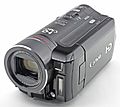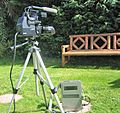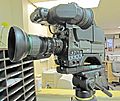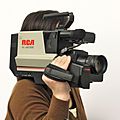Camcorder facts for kids
A camcorder is a cool electronic gadget. It combines a video camera and a video recorder into one handy device. The name "camcorder" comes from "camera" and "recorder."
Camcorders are different from mobile phones or regular digital cameras. Their main job is to record videos. They are usually portable and have everything built-in.
The first camcorders used videotapes to record. These were like small video cassettes. But now, most camcorders record digitally. They save videos onto things like internal flash memory, hard drives, or SD cards. New camcorders don't use tapes anymore!
Camcorders that don't use tapes are sometimes called tapeless camcorders. If a camcorder can use more than one type of storage, like a hard drive and a memory card, it's called a hybrid camcorder.
How a Camcorder Works
A camcorder has three main parts that work together: the lens, the imager, and the recorder. Think of it like your eye and brain working together to see and remember things!
The Lens
The lens is the first part that light hits. It's like the eye of the camcorder. The lens gathers light and focuses it onto the imager.
Lenses have some important settings:
- Aperture or iris: This controls how much light gets in. It also helps decide how much of your video is in focus.
- Zoom: This lets you make things look closer or farther away. It changes the focal length and how wide your view is.
- Shutter speed: This controls how long the imager sees the light. It helps make sure your video looks smooth, even with fast movement.
- Gain: This helps the camcorder see better in low light. It makes the signal stronger.
- Neutral density filter: This is like sunglasses for the camcorder. It reduces bright light without changing colors.
Most camcorders for everyday use can set these things automatically. But if you want to be creative, you can often change them yourself! Professional camcorders let users control everything.
The Imager
The imager is super important. It turns the light from the lens into an electrical signal. It's usually a CCD or CMOS sensor.
When light hits the imager, it creates an electrical charge. After a short time, the imager turns this charge into a continuous electrical signal. This signal is then ready to be recorded.
The Recorder
The recorder takes the electrical signal from the imager and saves it. In older camcorders, it saved onto magnetic videotape. Now, it saves onto digital storage.
The recorder does a lot of work to process the video signal. Sometimes, in older camcorders, the recorded video might not look exactly like what the camera saw live. But modern digital recorders do a great job of keeping the video clear and detailed!
Images for kids
See also
 In Spanish: Videocámara de mano para niños
In Spanish: Videocámara de mano para niños










